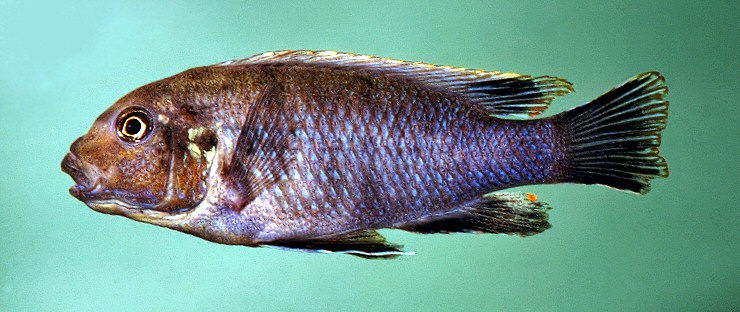The above photo, so far as I am aware, is the first one of Tropheops "lucerna brown"
to be published or posted. T. "lucerna brown" is an undescribed member of a group of
similar species, of which the only one that has been formally described and named is
Pseudotropheus lucerna itself. (Species in this
putative group have been assigned variously to Pseudotropheus or to Tropheops, and
some confusion remains. Tropheops is currently used on this site for T. "lucerna brown.") The eight or so species in this
assemblage usually have a slightly subterminal mouth (lower jaw often a little
shorter than upper, as in the individual in the photo above, so that the mouth opens
somewhat downward); generally have an irregular black spot on the soft rays of the
dorsal fin (also obvious in the photo); and inhabit the intermediate rock/sand zone
in shallow water.
T. "lucerna brown" has a narrow geographic distribution. It has only been found
along a restricted part of the western shore of the Southeast Arm of the lake, starting just
south of Monkey Bay (but not, apparently, at Monkey Bay itself).
Ribbink et al. (1983: 194) first identified this form
as distinct from P. lucerna, recording it only from
the small islands of Kanchedza and Mpandi (both of which are close to the shoreline), and
from "Chigubi" (Chingubi Point), Nkudzi, and Nkopola.
David Eccles and I captured the large male in the photo with a small seine
in less than 1 m (3 feet) depth on the south side of Chingubi Point. On the
north side of the point, the substrate consisted of sand strewn with patches of rocks
ranging from several centimeters (inches) to about 2 feet (2/3 m) across. Vallisneria
was the only higher plant present. I observed this cichlid species there and dipnetted some
small individuals with SCUBA. In contrast, the south side of the point, where this was
the most abundant species of Mbuna (we seined more than 30 individuals),
had a different substrate composed of cobble-sized rocks ("shingle," Eccles called them)
with no sand, no Vallisneria, and little or no gravel. Here, filamentous green
algae (Calothrix) grew lushly on shallow and exposed rocks — the mats
were up to 5 cm (2 inches) thick, which might resemble many herbivorous Mbuna's concept
of paradise.
The T. "lucerna brown" that we collected all had the black spot in the hind
part of the dorsal fin. I observed that, although all rays of the caudal fin were
frequently black, as in the photo, this was not true in all individuals. However, the
uppermost and lowermost caudal rays were black in every one. Males had an orange spot
in each scale on the flanks, seen only faintly in the photo.
Ribbink et al. (1983)
treated T. "lucerna brown" as part of their loose "Pseudotropheus 'miscellaneous'
species-group," providing brief notes on the life colors (but no photo) and even briefer
ecological and behavioral notes:
"Coloration. Nkudzi males: Body brownish ground colour with mauve, sometimes purple,
back and a yellowish-brown chest and belly. Head brownish, but mauve dorsally with yellow
chin and gular region. Dorsal fin mauve with conspicuous, large black fin-spot. Detailed
notes on other fin colours are not available.
"Nkudzi females: Body light brown with numerous black blotches on the flanks.
Most readily recognized by the conspicuous black dorsal fin-spot.
... This species frequents intermediate zones, favouring regions where small
rocks occur over sand. P. lucerna 'brown' has not been found below 4 m [13 feet]
depth and is most numerous in the upper 2 m [6½ feet].... Males are aggressively
territorial, but females are not territorial, occurring singly or in small groups....
Members of this species were observed feeding from the Aufwuchs mat."
Konings (1995c), in the second edition of his book
Malawi Cichlids in Their Natural Habitat, devoted one sentence (p. 213, citing Ribbink)
and no photograph to this poorly known species. Later, in the
third edition of the same title, Konings (p. 350, third column)
treated T. "lucerna brown" as a junior synonym of Tropheops novemfasciatus.
This decision, however, is clearly incorrect; his own photo of the latter species
(Konings, 2001: 221 photo 7) shows a more lightly built
fish with no black caudal rays and no trace of a spot on the soft dorsal rays.
Other fish species I saw (and, in most cases, Eccles and I collected) in the shallow intermediate
zone at Chingubi included:
Genyochromis mento, Labeotropheus fuelleborni,
Labidochromis cf. maculicauda, Petrotilapia sp.,
Pseudotropheus fuscus, Tropheops microstoma, T. tropheops (including an OB),
Dimidiochromis kiwinge, Mylochromis ericotaenia, M. incola,
Nimbochromis fuscotaeniatus,
Placidochromis subocularis, Protomelas fenestratus,
Trematocranus placodon, Tyrannochromis cf. maculiceps,
Oreochromis sp., Barbus paludinosus, B. johnstonii,
and Labeo cylindricus.
Several Mbuna species were notably absent at Chingubi Point, including
Melanochromis auratus, M. vermivorus, M. melanopterus, Labeotropheus trewavasae,
and, I think, Maylandia zebra.

